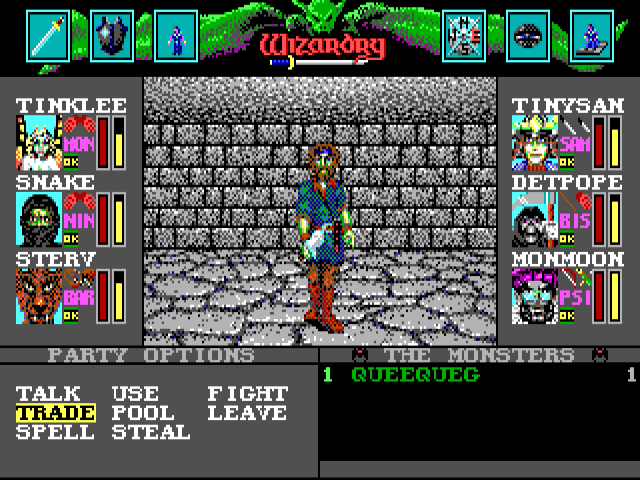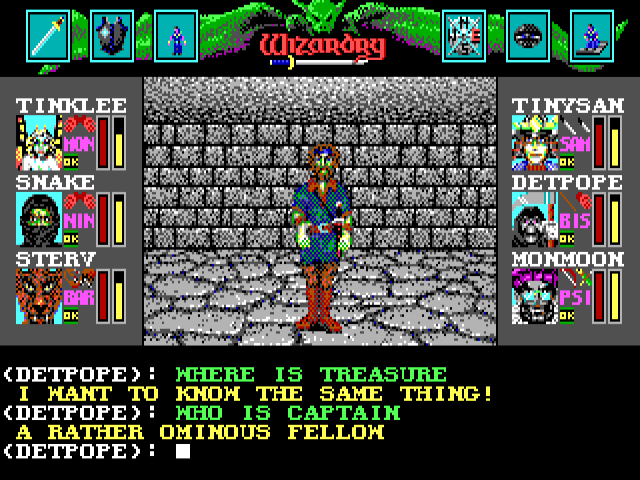FriendlyMerchant
Guest
They're just called blobbersI'm still waiting for an answer as to what you guys call the same exact games except with only one character.
They're just called blobbersI'm still waiting for an answer as to what you guys call the same exact games except with only one character.
Yes.Deutsch RPG?The better term is DRPG and it captures all of the various “blobbers”, including single-character ones.
(It’s actually for Dungeon RPG, if you’re curious. There’s a thread for an exhaustive list of Dungeon-RPGs but I’m pretty sure it’s in the JRPG forum)
Hard to agree with someone who believes that presentation doesn't affect how a game plays. If you get sent to the game over screen after stepping into a lava pit that looked like a pool of water, then you're playing a very different game than one with bright red lava, don't you think?The only difference between the two is indeed the visual representation and not the mechanics - or core gameplay (vs visual or narrative features), as Wikipedia puts it. Of course this assuming that the only interaction between said NPC and the PC is the one you described - ie. there isn't even a way to talk (even with a precanned response) and the NPC doesn't move at all. In practice at least, even the most primitive of JRPGs made in the most primitive of JRPG engines like RPGMaker 95 do have some additional interactivity, like a speech bubble and NPCs often tend to randomly wander around.
But if things are only just as you describe, a wall is a wall regardless of how it looks. As far as mechanics / core gameplay are concerned of course (and usually they aren't called walls but something more generic, like blocker or obstacle). From a narrative or visual design perspective it can be a wall, a very deep pond that your character can't cross, a building, a tree, a boulder, a lava pit or whatever else that still behaves the same.


The Donjon is the tallest tower of a castle.Yes.Deutsch RPG?The better term is DRPG and it captures all of the various “blobbers”, including single-character ones.
(It’s actually for Dungeon RPG, if you’re curious. There’s a thread for an exhaustive list of Dungeon-RPGs but I’m pretty sure it’s in the JRPG forum)
But...what is a Dungeon?
Markland Blake Clevemore is a moron. So if you're quoting him for proof, well see my original statement.







Hard to agree with someone who believes that presentation doesn't affect how a game plays. If you get sent to the game over screen after stepping into a lava pit that looked like a pool of water, then you're playing a very different game than one with bright red lava, don't you think?






of course visual representation changes how a game plays, there's a reason first person shooters and third person shooters are separate subgenres that share many mechanics but both have their own unique mechanics that plays to their strengths
But...what is a Dungeon?



People do not use this term to describe their own games, you don't see this term used to describe products. It's not a thing.

Interestingly enough I think sci-fi is better for making a more interaction-restricted game, because the player is going to have easier time recognizing his limitations when he finds out his tools need power/fuel compared to fantasy counterpart. The same goes for "it makes sense!" sentiment - a fantasy world has to put down some ground rules first and make sure they are followed, so the player can extrapolate what he can do from that. It's also easier to allow the player more free-form experience in sci-fi, because you don't really need classes to be able to use certain tools (although prior character-related experience is certainly going to benefit you), beyond having physical capacity to operate them (like intelligence or strength).The visual representation being referred here is things like having stone walls vs metal walls (that still behave the same by disallowing the player to progress past a point) or an elevation spell vs a jetpack (that still behave the same, i.e. helping the character fly upwards and use some consumable like mana/fuel).
Adding another point to an old conversation.
People do not use this term to describe their own games, you don't see this term used to describe products. It's not a thing.
Spotted this in Wasteland 3 today!







Interestingly enough I think sci-fi is better for making a more interaction-restricted game, because the player is going to have easier time recognizing his limitations when he finds out his tools need power/fuel compared to fantasy counterpart.
Spotted this in Wasteland 3 today!








